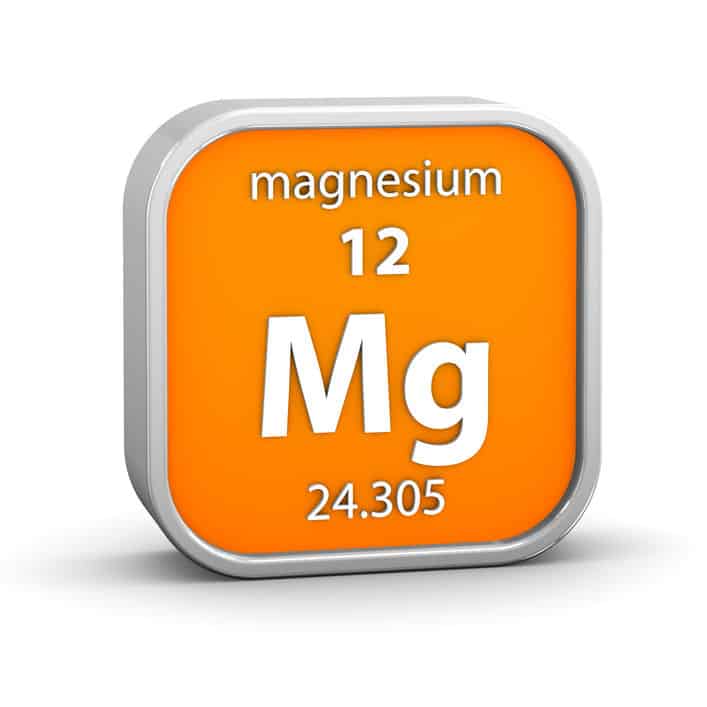

A substance known as magnesium oil delivers magnesium through the skin so it can be directly absorbed by the body’s cells. Known as transdermal magnesium therapy, this topical mineral application could be applied by bodyworkers to help people with a specific set of ailments. Although a conclusive amount of research on magnesium oil has yet to accumulate, the information currently available represents a potentially exciting, new era for massage therapists.
Magnesium is an essential mineral that is needed for more than 300 body functions. Despite it being required for the optimal functioning of so many body systems and being utilized by physicians for several different types of health crises, up to 50 percent of Americans are deficient in magnesium. Most people are unaware that they lack this vital mineral, yet magnesium deficiency is suspected as a cause or consequence in a wide range of chronic diseases.
While certain dietary changes may improve magnesium levels, transdermal (delivered through the skin) magnesium therapy has been stirring up great interest in the medical community. Because it is relatively safe and can help with musculoskeletal pain and relaxation, some massage therapists are investigating the use of magnesium oil to offer a greater therapeutic session to their clients.
As suggested by American physician, scholar and author Mark Hyman, MD, magnesium can be thought of as the relaxation mineral. Any part of the body that is tight, irritable, crampy and stiff can be a sign of magnesium deficiency. Symptoms of magnesium deficiency might include:
- Being easily startled
- Muscle cramps or twitches
- Insomnia or irritability
- Anxiety or palpitations
- Constipation or anal spasms
- Headaches or migraines
- Fibromyalgia or chronic fatigue
- Obesity or high blood pressure
- PMS or menstrual cramps
Besides inducing a relaxation effect in the body’s muscles, magnesium breaks the chemical cascade that leads to inflammation. Thus, magnesium eases tension and protects the body from a number of chronic diseases. In the book Transdermal Magnesium Therapy: A New Modality for the Maintenance of Health by Dr. Mark Sircus, L.Ac., OMD, magnesium is shown to increase oxygen to the cells, protecting us from:
- cancer
- stroke
- heart and vascular disease
- Alzheimer’s disease
- multiple sclerosis
- endocrine problems
- diabetes
- pain
- insomnia
- depression
Taking oral magnesium supplements may be helpful for certain individuals, but is not always absorbed. Magnesium oil appears to be easily absorbed through the skin, directly into the body’s tissues. A 2010 study published in The Nutrition Practitioner found that the application of transdermal magnesium substantially raises magnesium levels within the body over a relatively short period of time. According to Dr. Sircus, magnesium chloride, applied transdermally, is the ideal magnesium delivery system with health benefits unequalled in the entire world of medicine.
Magnesium oil isn’t actually an oil, but rather a mixture made by mixing flakes of magnesium chloride with purified water. The magnesium oil is applied to the skin’s surface and then diffuses out of its vehicle (water) into the skin:
- First is diffuses into the stratum corneum, where a reservoir of magnesium builds up.
- Then, the magnesium diffuses through the stratum spinosum, where it can be metabolized and binds to receptors to exert its effect.
- Finally, magnesium is delivered into subcutaneous fat, the circulatory system and achieves rapid systemic absorption.
As well as the potential benefits magnesium oil could have for many chronic health conditions, it appears to be very useful for relaxing and relieving painful muscle and/or nerve problems. In fact, a clinical trial evaluating the use of transdermal magnesium therapy is underway right now at the Mayo Clinic in Rochester, Minnesota for participants with fibromyalgia. Likely because it is a vasodilator and smooth muscle relaxant, magnesium oil appears to:
- Provide pain relief
- Induce muscle relaxation
- Benefit arthritis
- Ease muscle cramping
- Help soften muscles and connective tissue
Massage therapists could use magnesium oil directly on affected areas or treat it like a specialized essential oil, mixing a small amount into a carrier oil. In general, daily spraying or massaging an ounce of magnesium oil on the skin of a large sized adult is considered to be sufficient.
Sports massage therapists could add therapeutic value to their session by using magnesium oil to treat and prevent injuries. Because transdermal magnesium enhances tissue recovery, reduces pain and inflammation and increases muscle, tendon and ligament flexibility, magnesium oil is ideal for working with athletes.
In general, transdermal magnesium therapy is well tolerated. However, it is not without hazards. Excess magnesium is normally excreted from the body, unless there is impaired kidney function or severe renal insufficiency. In addition, magnesium oil is essentially a salt solution which will irritate or sting if applied to a laceration or broken skin. Magnesium oil is highly concentrated, so a slight tingling or itching sensation on skin can occur even on intact skin.
In his book, Dr. Sircus warns that “Magnesium toxicity can occur in people with hypothyroidism, those using magnesium containing medication such as antacids, laxatives, cathartics, and those with certain types of gastrointestinal disorders, such as colitis, gastroenteritis, and gastric dilation, which may cause an increased absorption of magnesium.” In addition, magnesium may negatively interact with Amiloride, Calcium Acetate, Dexamethasone, Misoporstol, Spironolactone and Triamterene, and could reduce the effectiveness of Warfarin, Tetracycline and Doxycycline.
It will likely be another year before the results of Mayo Clinic’s transdermal magnesium study for fibromyalgia are published, and many more before a significant body of evidence accumulates regarding magnesium oil’s safety and efficacy. Barring clients with kidney problems or any of the other contraindications, investigating the use of transdermal magnesium therapy for a massage practice is an exciting prospect for the future.












I have Mg oil. It is much more than “a slight tingling or itching sensation” on most parts of my body. I am a massage therapist and I would NEVER use this on my clients. Waaaay too irritating. Unless someone comes up with a way to block that side effect….
according to information I have read, the greater the itching/tingling (or down right stinging), the greater the deficiency. Over time with regular use of the oil the unpleasant sensation should diminish.
Mixing with an oil like coconut might temper the burning sensation of the Mg oil, but still, some parts of my body are too sensitive to it, and I think the same would be true of clients….
Most of us have used Magnesium Sulfate topically (Epsom salt) in a foot bath , etc. And we do that to absorb magnesium thru the dermal layers. Why not use this source for topical application instead of a soak ?
I am a massage therapist and I have been using magnesium oil (magnesium chloride) for some time. You must be knowledgeable about the meds the client is using and their liver and kidney function. Never use the oil directly on the skin. Greatly dilute with a carrier oil. No one is ever the same, so I will use this solution only on a small area the first time. Upon their next visit they tell me they had no reactions, then I will use it to problem areas of their body. I don’t apply it to areas that may be more sensitive. If you use too much, it has a drying and itching effect. Morton Salt has a lotion with magnesium sulfate (Epsom salt). It can be found at Walmart and other pharmacies. It is a good product as well.
Hi Tim, Thanks for this information. Where do you buy your Mg. Oil? Also do you dilute it with a carrier oil like suggested? Also, What is the name of the lotion sold at Walmart? Sorry for all the questions! Lol!
Cheers,
Hermene Anderson, LMT
i have a topical magnesium sulfate cream that is awesome to use in deep tissue sessions, or with fibro clients!
Hi Alex!
I’d like to know the brand name of the cream you are using. I have two clients that suffer with fibromyalgia and I would like to try it on them. Please personally email me if you can. heart2hands@mac.com
Thank you so much!
Namste,
Hermene
can you use Milk of Magnesia?
The itching of the skin usually occurs after absorption because it leaves behind a salty residue. This is similar to having ocean water on your body that itches when it dries. The secret is to wash it off 🙂 I tell my clients to let it absorb for 15-20 min. and then to wash off the residue with a warm wash cloth. Or to spray it on 20 min. before they are going to shower. Solves that problem. If you mix it with another carrier it could effect absorption. I like Ancient Minerals magnesium spray or oil. Also I would advise against massaging it in. I usually apply after the session because adding friction during application will only cause further irritation to the skin. Having said all that I have had maybe 3 out of say 100 people tell me it irritates their skin. Perhaps it is due to the brand I use being such high quality. I also have clients purchase it for themselves and the vast majority enjoy using it.